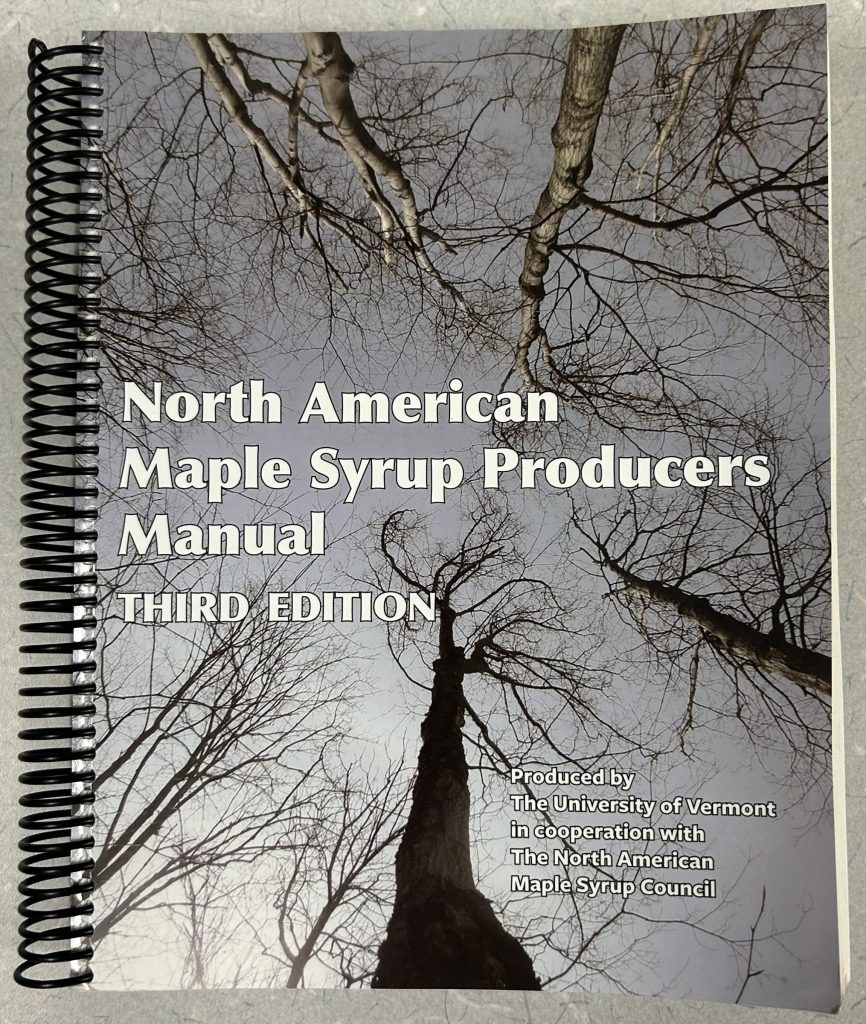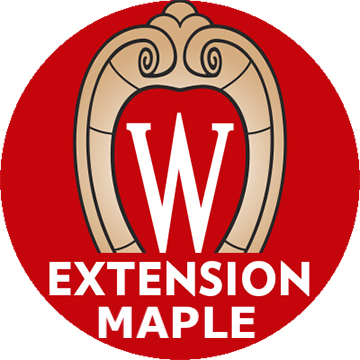Making Maple Syrup

This page features information tailored for beginning maple syrup producers, although established producers may find value as well. Last updated – Jan. 2025
Step-by-Step Guide to Make Your Own Maple Syrup
These resources provide step-by-step assistance for anyone interested in making maple syrup.
(Click the (+) to expand the content)
Basic Equipment Needs
Supply List for Beginning Producers
- 5/16” Spouts (Choose spouts made of food-grade plastic or stainless steel)
- 5/16” Drill bit (Choose a maple specific drill bit matching your spout size)
- Battery-powered drill
- Rubber mallet (Hammers can also properly set taps, if used carefully)
- Food-grade plastic or aluminum buckets with lids (Or sap bags with metal hanging brackets)
- Food-grade storage vessel for hauling and storing sap between runs, and boiling (like 5 gallon buckets with lids)
- Boiling pan with wide surface area (like full-size catering pans measuring approx. 20.75″ x 12.75″)
- Outdoor boiling method (cinderblock fire pit, converted 50 gallon drum or 275 oil tank, etc.)
- Fuel source (wood, oil, propane)
- Defoamer (options include vegetable oil, or synthetic products from maple suppliers. Use as little defoamer as possible)
- Long stemmed candy thermometer, or hydrometer with cup
- Cone filter or cheese cloth
- New mason jars or maple jugs and lids
This list and the information linked to each bullet were put together by the University of Maine Cooperative Extension Maple Syrup Production Program.
Getting Geared Up for Maple Sugaring
This six-page bulletin was developed in 2023 by Jason Lilley, Assistant Extension Professor, Sustainable Agriculture and Maple Industry Educator, University of Maine Cooperative Extension Maple Syrup Production Program
Maple Tree Identification
The first step of production is identifying the trees that can be used to make maple syrup. The most commonly tapped maples in Wisconsin are the sugar maple, red maple, and silver maple, but other species can produce syrup as well.
How to Identify a Maple Tree (9 min)
Online Tree Identification Tool:
Maple Identification and Distribution in Wisconsin (47 min)
Choosing Which Trees to Tap
After identifying your maple trees, its time to select the best trees to tap for optimal sap production. The commonly tapped maple species in Wisconsin are the sugar maple, red maple, and silver maple, but every tree is different. Consider the information below when choosing which trees to tap in your sugarbush.
How to Tap Maple Trees
After identifying the best maple trees for optimal sap production, it’s time to tap your trees.
Tapping Maple Trees for High Sap Yield (5 min)
Comprehensive Tree Tapping Clinic (1 hr)
Maple Sap Flow and Collection
As winter thaws and sap starts to flow out of tapped spouts, you’ll need to collect and store the sap, keeping it clean and cold, until it’s time to cook. Some common methods used in small-scale production are outlined below.
Maple Sap Flow and Collection Overview (2 min.)
Collecting Sap with a Bucket (3 min.)
Introduction to Collecting Sap with a Bag (4 min.)
Turning Maple Sap into Syrup
Overview of Turning Maple Sap into Syrup (2 min)
How to know when the syrup is done?
Saving Energy and Time with Reverse Osmosis (2 min)
Filtering and Bottling Maple Syrup
Once your sap has reached the correct sugar content, it’s time to filter and bottle your maple syrup. The resources below help explain when maple syrup is finished cooking, and how to ensure you end up with a clear, delicious, and shelf stable final product.
Filtering Maple Syrup
Maple Syrup Production
This 10 min. video from the Wisconsin Maple Syrup Producer’s Association (WMSPA) provides an introduction to the process and equipment required to make maple syrup.
Learn more about the WMSPA at wismaple.org
Wisconsin Maple Syrup
The Maple Syrup Process
From Tree to Table
This 1 hour presentation, by UW-Madison Extension Natural Resources Educator Bill Klase, walks through the basics of making maple syrup, from tree to table.
Learn more about the Extension Forestry program at woodlandinfo.org
Ready to take your maple knowledge to the next level?
Since 1958 the North American Maple Syrup Producers Manual has served as a basic reference source for the production of pure maple products. This 2022 edition provides up-to-date, science-based information and recommendations relating to all aspects of the industry. The guidelines presented will help users ranging from the hobby and beginning producer level to those well-established in the industry. In addition, the information herein will benefit foresters, land managers, Extension and outreach personnel, and others aiming to provide assistance to those in the maple industry.

This publication is also available in print, at www.mapleresearch.org/ordermanual or Download resource here.
Additional Resources
(Click the (+) to expand the content.)
Getting Ready for Sugaring Season (48 min)
WI Maple Hour: Getting Ready for Sugaring Season
Jim Adamski, sales consultant with CDL Wisconsin, shares pre-season preparation tips for all aspects of your maple syrup operation. Read the summary article HERE.
End of Sugaring Season Clean-up
WI Maple Hour: End of Season Clean-up (28 min)
Theresa Baroun, Executive Director of the Wisconsin Maple Syrup Producers Association, joins the Maple Hour to discuss end-of-season cleanup for all aspects of your maple operation. Read the summary article HERE.
Additional Resources:
Energy Considerations
Maple syrup production is an energy-intensive process. According to the Ministry of Agriculture and Food in Ontario, Canada, it takes 400,000 to 500,000 BTUs of energy to produce one gallon of maple syrup (equivalent to 2.7 to 3.4 gallons of fuel oil or 0.06 to 0.08 face cords of maple firewood/gallon of syrup). Energy is a major component in the cost of production, accounting for 26 to 34% of the production costs without reverse osmosis and 8 to 11% with reverse osmosis based on using wood or fuel oil, respectively. For ideas and resources on energy efficiency in maple syrup operations, check out our maple syrup energy site.
WI Maple Hour: Energy Efficiency (48 min)
Other internal resource pages
Check out our ‘Sugarbush Forestry’ page for resources about managing your sugarbush for health and resiliency to ensure consistent sap production now and into the future.
If you’re interested in turning your passion for maple syrup into a business, our ‘Selling Maple Products’ page has some great resources to get you started.
Other helpful links
Many other organizations and state Extension programs have good information on maple syrup production. Here are a few that we recommend:
- Wisconsin Maple Syrup Producers Association, including A Beginner’s Guide
- University of New Hampshire Beginner Maple Syrup Producer Tips
- University of Vermont Extension Maple Program
- Cornell Maple Program
- University of Maine Cooperative Extension Maple Syrup Production
- Penn State Extension Maple Syrup
- North American Maple Syrup Council – MapleResearch.org
Upcoming Events





